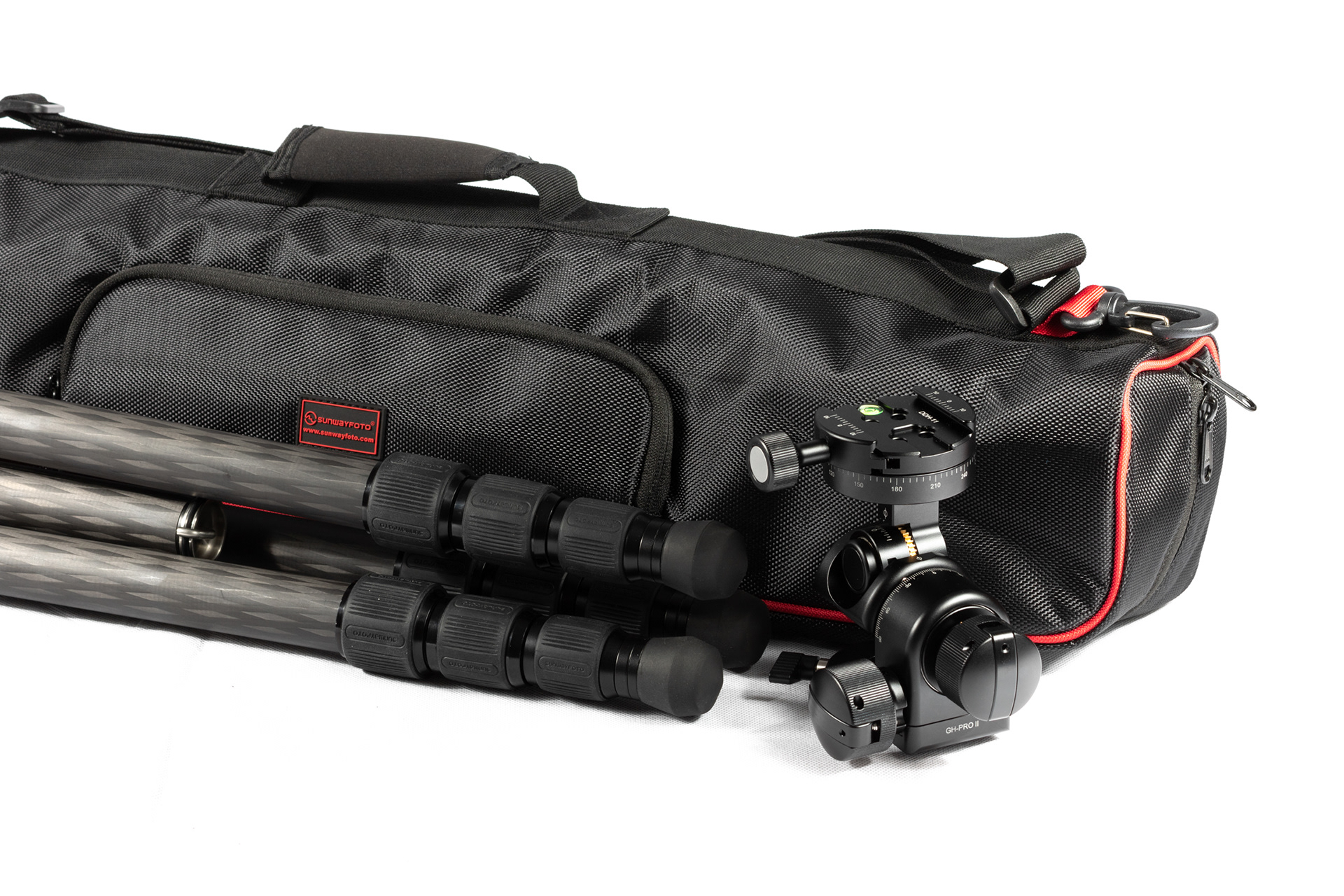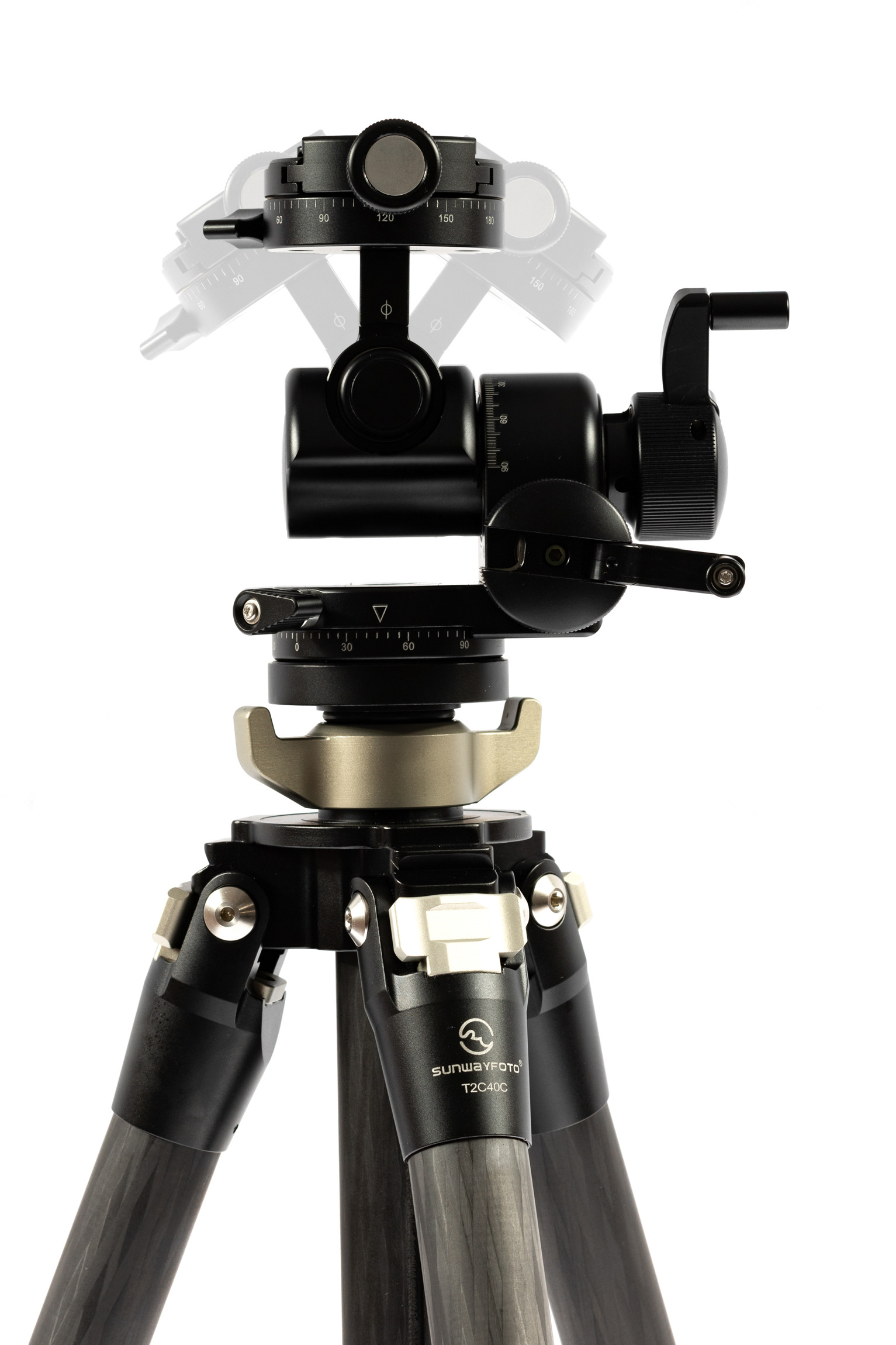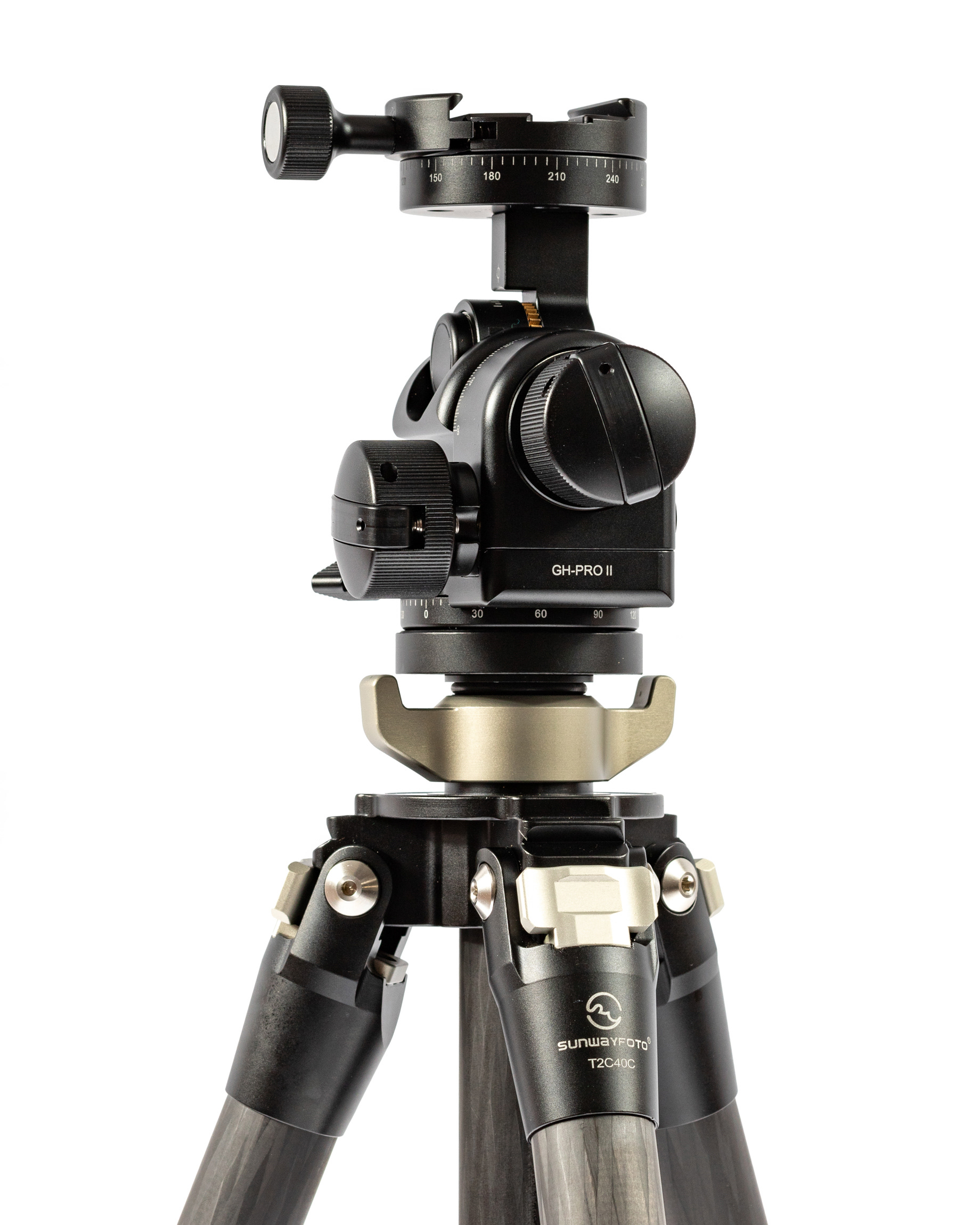GH-PRO II GEARED TRIPOD HEAD
Build and Design
This geared tripod head from Sunwayfoto is comparable with other geared heads in terms of weight, and is made from high quality aluminium to keep it strong and sturdy. Geared heads can be heavier than ball heads, and even pan and tilt heads, but that extra weight makes it feel reassuringly solid as a base to attach your camera to. This can lead to tripod setups being slightly more top-heavy than you might want, but this can be countered by attaching a weight to the centre column hook of your tripod to lower the centre of gravity back down.
The overall size of the head is impressively compact. Sunwayfoto have worked hard to maintain the compact nature of the series from the first model released previously, and when compared to geared heads from other manufacturers it shows more normal proportions against their ungainly mutated looks. Unfortunately, when mounted to Sunwayfoto's T2C40C carbon fibre tripod, the whole system is too tall to fit in the carry case that comes included with the tripod, but that is something I hope Sunwayfoto can address moving forward.
Another benefit of the Sunwayfoto design is that the camera mounting point maintains a central position above the pivot point of the whole system, helping to minimise parallax problems in panoramic shooting/stitching. Of course, this alone does not always completely solve the problem, but in conjunction with other accessories it should be possible to take many panoramic frames and stitch them together without issue.
The biggest reason for using a geared head is of course the gears, as they provide a means by which you can fine tune your composition with almost infinite accuracy. The gears on this model only cover two planes of adjustment unfortunately (lateral tilt and fore-aft tilt), but are well made and designed to integrate into the design without weird protrusions spoiling the aesthetics. Other geared heads might be less pretty than this one, but lots of them offer geared adjustment in all three planes. Sunwayfoto has responded to this by introducing the GC-01; a replacement clamp that adds geared panning adjustment to your setup. In fact, this can be added and removed as you see fit, and is also compatible with ball heads too. I plan to review that piece of equipment properly soon. The only potential downside of the design is the the gears are slightly exposed in some places, which could be an issue with dirt and dust entering the system, ruining the smoothness of movement.
The adjustment knobs are a unique feature to this style of head, with the traditionally large designs that allow good grip and feel when making minute adjustments. One issue though, is that sometimes you want to make larger, faster adjustments before honing in on your subject more acutely - spotting a landing insect on a flower below your field of view for example. There is only so much speed you can turn an adjustment knob, so Sunwayfoto has included flip out crank levers that allow you to wind the gears much quicker. Their flip out design keeps the overall profile sleek and their closed position keeps them protected.
The panning base is marked for precise adjustments with a lock knob that can be pulled out and rotated so it sits aligned with the base for convenience. Likewise, there is panning adjustment built in to the top clamp, making this a very versatile system. The top clamp is Arca Swiss compatible, with a built-in bubble level.
Operation and Usability
The GH-Pro II looks cool, and is as good to use too. The gears are super smooth, and whether turning the adjustment knobs in tiny increments, or using the crank handles to make larger adjustments, fine tuning your composition is an absolute doddle. Whatever your genre of photography, a geared head has so many advantages over other head types. With perhaps the exception of sports and wildlife where a gimbal head makes more sense, a geared head can help you be as precise as you want to be without the frustration creeping in that other heads can cause.
For me, my architectural and interior photography work has benefitted greatly from this head, as I can now align my camera perfectly with verticals and horizontals to avoid converging lines in my images where I don't want them. There are edits you can do in the computer, but to get it right in camera is always the best approach, and I can work more quickly and efficiently with the precision this head offers me. I do sometimes feel I lack the gearing on the panning plane, but the addition of the GC-01 should complete this setup nicely for me.
Even without the GC-01 though, the panning base and clamp features are quite stiff to adjust, offering plenty of resistance as you turn them. This is a good thing, because it helps you to move the tripod slowly and carefully, increasing your accuracy before gearing has even been introduced to this plane.
There are some instances where I miss having a gear on that plane, despite the GH-Pro II's proficiency though, both in my property photography work, and in macro photography. Sometimes the adjustment accuracy simply isn't quite precise enough, or easy enough to bring into alignment. This is exacerbated by the fact that when you lock the lock knobs for either the panning base or clamp, the tightening of the system causes your camera to rotate ever so slightly. You can take this into account and prepare accordingly, but the whole point of a geared head is that it makes these sorts of adjustments as easy as can be. It will certainly be interesting to see how the GC-01 improves this aspect of operation.
The range of movement in the geared planes is impressive, and easily enough for my needs. The fore-aft plane offers 180° of movement - from 90° straight down to 90° straight up - while the lateral tilt covers 80° of range. The panning plane is covered by 360° of movement in both the base and the clamp, which is useful for aligning the whole head in the right direction for operational use (I like to keep the gears pointed the same way each time I use it for ease of adjustment), and for aligning your camera if last-minute adjustments are needed.
I use the crank handles much less than just the knobs themselves, but for larger, quicker movements they are a big benefit. There is something very satisfying about flipping them in and out, and the handles on them rotate so that there is no friction when holding them in your fingers while turning. That's a really nice touch.
The feeling of having so much control and precision at your fingertips instills a lot of confidence in your workflow, and it removes a barrier preventing you from quickly composing the best shots. Obviously for architecture, the speed and confidence gained is a real boost, but also in macro photography as I mentioned too. The other area I didn't expect to make massive gains in was my long range landscape photography. I used to mount my camera on a ball head, and while this offered me completely fluid freedom of movement, often you don't actually want so much freedom. To work carefully and methodically (but not necessarily slowly), locking off one plane of adjustment at a time leads you to success quicker than battling with having to get every plane lined up at once before locking off the whole system. Using my 70-200mm lens, I would line up my composition perfectly - after a battle to find the composition with the ball head - only to find that in tightening up the ball head my camera would drop slightly as the system settled into place. This is no longer an issue whatsoever, as the geared adjustments allow perfect raising and lowering of the camera and lens, with no slackness in the system to ruin your hard work.
There is a bubble level built into the clamp, but this is covered by your camera upon mounting which could be a pain for some people. I don't find that an issue though as I rarely use tripod based bubble levels anyway, preferring to adjust either by eye, or using the level built into my camera.
Speaking of outdoor photography, it is unclear how the system will hold up over time with the slight exposure of the gearing in places, as dirt and dust could become an issue. But, like with anything, if you look after and maintain your kit properly, you should be able to avoid this becoming an issue. I shall certainly revisit this review in a few years to confirm the products long-term longevity.
The last thing to note in this section is that the attachment to the top of my T2C40C tripod is very secure, and while my previous tripod and ball head would come loose from one another regularly, I have no such issues with this pairing. It is also compatible with my T1C30N mini carbon fibre tripod which means that I can use it for low down shooting to help me with macro subjects. That is a real setup to behold, and reminds me of the vast range of customisation that Sunwayfoto offer with all of their accessories and base kit. I am hoping to add a macro focussing rail to my setup to add gearing to my zoom/focussing adjustments too, so keep an eye out for that review when I receive a sample product.
Summary
Easily the best tripod head I've ever used, and one that has some clear advantages over its rivals. It's smooth, precise, feature-packed and compatible with lots of additional accessories. It is intrinsically lacking in the area of pan gearing, but this is solved with the addition of the GC-01 geared clamp.
I have used this tripod head since the start of 2020 in my landscape and property work, and it has comprehensively improved my efficiency and accuracy. It's also very satisfying to use if, like me, you have a bit of OCD.
There have been a good number of people who have commented inquisitively on it, and several photography friends who have expressed real desire to convert to a geared head themselves having tried it out.
Pros:
- Sleek and compact design compared with rivals
- Smoothness and range of gearing
- Range of extra little touches, like the crank handles
- Arca Swiss compatible
- Central camera positioning
Cons:
- Exposed gearing in some places could be vulnerable to the elements
- No integral gearing on the panning plane






